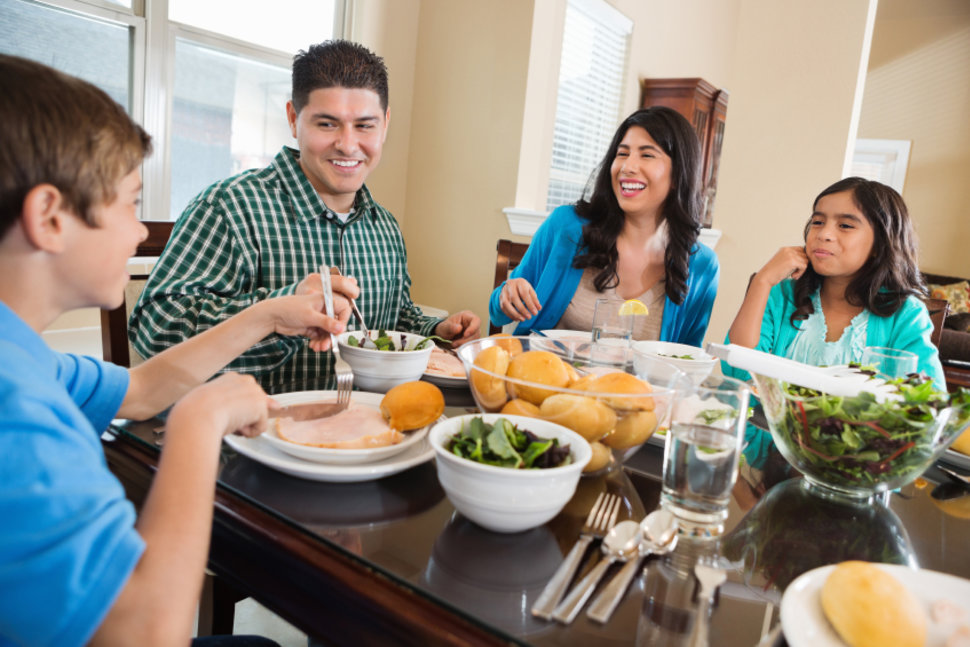FOR MANY FAMILIES, August is a time to get those back-to-school lists taken care of, schedule after-school activities and prepare for the kids to wake up early enough to eat breakfast and get out the door. For parents, it can be overwhelming. After getting the kids dressed, throwing breakfast together and packing lunches for everyone, making plans for dinner at home can fall by the wayside, especially with homework and extracurricular activities added back to the schedule.
This is an issue for almost every parent I know, so I reached out to my dietitian colleagues for their best time-saving and nutrition-rich advice to get dinner on the table during back-to-school season. From weekend planning sessions to emergency freezer meals, these expert tips can help keep the family nourished without a food show-like production:
Plan meals based on the family schedule.
Planning is a crucial step when it comes to getting dinner on the table. When we think through everyone’s schedule for the week, we can plan meals that take little to no preparation for hectic days and spend a little more time in the kitchen on days with a calmer agenda. “I have to look at our family schedule and realistically assess how hectic our evenings will be,” says Sarah Marjoram, a registered dietitian nutritionist and mom of three active children. Marjoram adds that “setting aside a little time to meal plan and making one big grocery run saves time, money and stress during a busy week. And I always embrace any opportunity to repurpose ingredients. If we grill chicken for one night’s meal, I grill double the amount so that we have prepped ingredientsfor another night.” As a meal planner myself, I pick one day a week to plan meals and stick to that day. Knowing that Sunday or Monday is my planning day helps me remember to get the plan done each week.
Keep your favorite recipes handy.
Keeping your favorite recipes close by helps when you want a sure-thing meal. Megan Byrd at The Oregon Dietitian says to “print out recipes and start keeping the ones you like in a binder with the rest of your cookbooks. If you find a super easy one or one that your whole family likes, save it in the binder for later. Keep it simple!” This can help with planning when you’re short on time and ideas.
Prep what you can ahead of time.
If a recipe calls for me to chop a bunch of vegetables on a busy evening, it’s unlikely that I’m going to follow through. This is where planning and prepping ahead can help save time, and your weeknight sanity. Natalia Stasenko of Feeding Bytes suggests prepping items to be used for “deconstructed” dinners and plans one to two of these no-cook dinners each week. She says the sandwich bar, baked potato bar, pasta bar, quesadilla bar or salad bar are all popular in her home. “Minimal cooking is involved, and all the components can be put away in the fridge to be reused for lunchboxes or other meals. An example of a quesadilla bar: tortillas, shredded cheese, black beans, chopped tomatoes and avocado [and] leftover chicken. Everyone can make their own quesadilla, and there is no cooking involved.” Stasenko adds.
Prepping for the deconstructed meal not only saves time on busy evenings, it gets kids involved with the meal. They can help with all stages from planning and prepping ingredients to setting the table and building their own plates.
Don’t forget about the freezer.
Each week I start planning by taking an inventory of things I have in my freezer like ground beef and mixed veggies. This helps me use what’s on hand. When I reached out to other nutrition experts, they had some great ideas on how to use the freezer in other ways.
“I use the last weeks of summer to try out new, easy meal ideas so that I’m ready with quick meals I know my family loves,” says Jenna Braddock, a registered dietitian nutritionist, blogger at Make Healthy Easy and founder of Off-Season Athlete. “This summer I have focused on finding frozen meals I can add to my dinner routine.” She points out that the frozen section in the grocery story is always adding new products, so it’s worth taking the time to give it a look.
Emma Fogt, a registered dietitian nutritionist and CEO of Fuel Up for Success, adds that having meal items in the freezer for emergency backups can really help on days when there’s no time to prep. She says she’d come home and work from the freezer stash with some frozen turkey or Swedish meatballs, boil some pasta , add marinara from a jar and fresh salad to the meal, or make Asian dumplings, with rice and edamame – all from the freezer. “Many flash frozen foods are awesome in a pinch,” Fogt says.
Use the slow cooker on your busiest days.
This is something I do more and more as my family gets busier. It’s how I cook ahead chicken breasts to be used in other recipes. Just cooking chicken breast for three hours makes them tender, so they can be shred in a flash. Shredded chicken can be used immediately or placed in the fridge for dishes like chicken pot pie, stir-fry bowls or tacos on another day.
“The slow cooker is my best friend,” echoes registered dietitian nutritionist Yaelle Joselit. She uses it to make a turkey roast, and then serves that with roasted veggies. Turkey roast can be served in many ways: on its own, with a side of vegetables, whole grain pasta or rice, or another day in sandwich or wrap form with greens and a dipping condiment of choice, she says. “The kids like the variation and it definitely saves time on busy days.”
There are many ways to get a busy family around the dinner table during the week but it seems the most critical step is planning for it to happen. If we think through a busy week, we can plan to sit down together in spite of a tricky schedule. In addition to having a nourishing meal, spending time around the table helps kids develop important life skills and allows families to connect.




